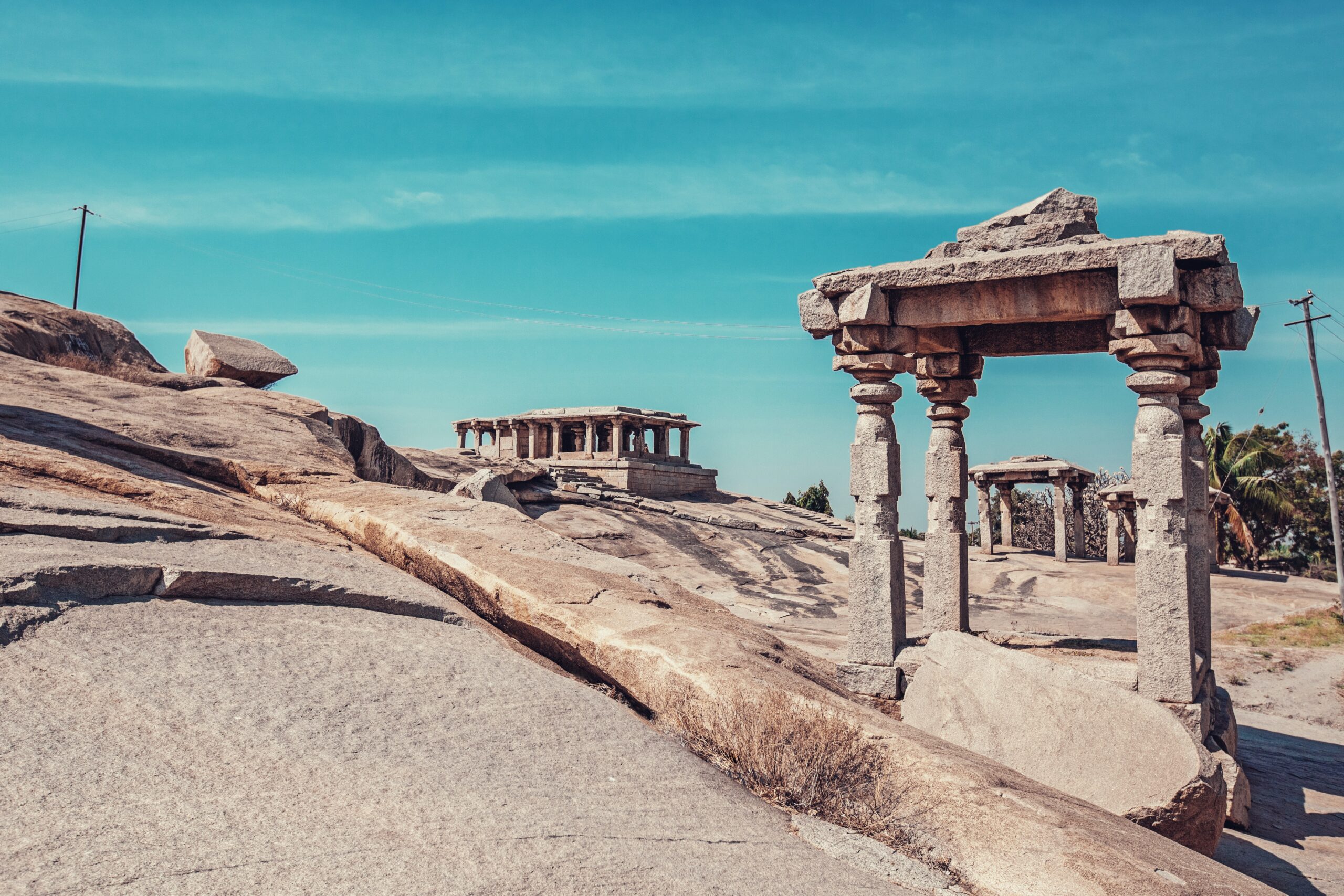Hampi Tour Planning – Places to Visit in Hampi
Hi everyone, I hope you guys are doing well. If you’re here you are probably planning for a Hampi tour. You should visit Hampi once. Doing something different from a regular routine is very essential for good health, relation, mind and for you. A tour to Hampi should never get canceled due to any reason. Hampi, it’s once in life time experience, like never seen before – the place, feel, and experience. Everything in Hampi is just beautiful and amazing.
Here, in this guide, I’m going to share my experience from the Hampi tour which I have done in the first week of November 2021. I’m also going to share what we did and how we did to enjoy the tour to its fullest.

Let’s get started!
I stay in Goa, the beach state of India. We have planned to reach Hampi by road driving ourselves.
Why Hampi?
First thing first, why Hampi and not other places near goa? (I stay in Goa and will talk about it soon). Hampi is a small village, temple, ruins, and boulders town located in central Karnataka. Hampi is famous for its ruins belonging to the Hindu kingdom of Vijaynagar. The World’s largest and richest kingdoms. Almost the entire area of Hampi comes under the UNESCO World Heritage site declaration.
Hampi’s unique ambiance demonstrates excellent workmanship and architecture through temples, sculptures, and monuments. Which adorns and makes the ancient city of Hampi proudly stand upon the bank of Tungabhadra.
More on Hampi here
How we planned the Hampi tour?
For us going to Hampi and coming back to goa was a 3-day tour. We executed this tour to Hampi in the first week of November 2021. This is in line with what you find when you search for “best time to visit Hampi” over the internet. The answer you get is October to March.
We drove our car (Renault Kwid) to Hampi which is around 359 KM. Most of the time we were on NH 67 which passes through Dharwad > Hubli and it took us 8 hours including two 30min breaks/rest in an interval of 3 hours drive.
After Hubli around the side of NH 67, we saw lots of Sunflower fields. Trust me, it is so mesmerizing that we couldn’t control ourselves from stopping at one such sunflower field to click a bunch of photographs.
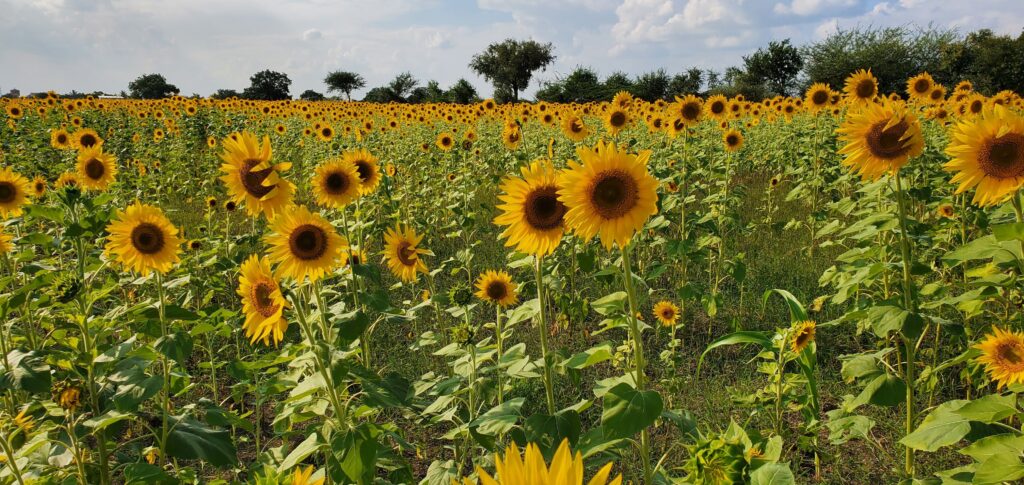
Next, comes, where we stayed for 2 nights and 3 days? How much does it cost to stay in or around Hampi?
So for the first day, we reach Hampi around evening 6 pm. There are several options in Hampi for a stay. Like homestay, hotels, or resorts. Since October to March is the tourist season in Hampi almost everything was running full. I suggest one should pre-book a stay online if you are coming to Hampi during tourist month. But if you are a person who is not comfortable booking a stay without seeing it, then you are not alone, even we are on the same plate.
To inspect the stay before finalizing, there are several options in Hampi. Homestay is not an option but if your budget is high you can look for a resort (eg: Heritage Resort Hampi, Kishkinda Heritage Resort, etc). Resort in tourist season will cost you 7000 INR or more. Other options are hotels in Hampi, budget-friendly hotels which I personally liked and I will recommend are – Clarks Inn Hampi or Kstdc Hotel Mayura Bhuvaneshwari. But there is very little chance that you will find available room for walk-in booking in tourist season.
If nothing worked for you, similar to us, or staying in Hampi is above your budget then the best option for you is to look out for a stay in Hospet (officially Hosapete). Hospet is a city and district headquarters of Vijayanagara district in the Indian state of Karnataka. It is located on the banks of the Tungabhadra River and is 12 km from Hampi.
Hospet has several stay options, like 100s of good hygiene and budget-friendly hotels ( even in tourist season). You find available rooms in hotels here easier than in Hampi, this is for walk-in booking folks.
How did we enjoy nature and the beauty of Hampi?
So on the second day after spending a very comfortable relaxing night at Pai Hotel in Hospet and having delicious idli and dosa breakfast. As we were moving out from the restaurant toward our car we were approached by a few tuk-tuk drivers. Even though we had thought of taking our own car initially we gave them a chance to propose thor offer in front of us.
So the tuk-tuk drive with a Hampi site map started explaining what service he will provide. It was nothing much, he just going to take you to all the popular temples, monuments and sculptures of Hampi (even any place you wish for) drop you there suggest you few things like how to visit what will be charged, how much time it will take to see this place and where to meet him again.
He initially asked for 1800 INR but then settled for 1500 INR. You know what! It was worth it. He took us almost all the major glory of Hampi in the proper order possible. Directed us very nicely. Also by hiring him to drive us to several sites we were away from driving and parking hassle, which also saved a lot of time.
Our pace of absorbing the beauty and purity of Hampi wonders was quite fast/high. Due to this, we were able to cover most of the Hampi sites and still got time to cover Hippie Island. Which originally would have been covered on our 3rd day.
Since we are already in Hampi and nearby Hippie island, tuk-tuk directly charged us an additional 300 to take us to Hippie island.
NOTE: Since we are residents of Goa and Hippie island pretty similar to goa in terms of nature. We just wanted to visit a few places, like the monkey temple (birthplace of Lord Hanuman) in Kriskinda, ride on a Coracle boat, etc.
Monkey temple is on the top of a hill, to reach there you need to climb up 575 steps and have a relatively impressive view at the top. There is a spot for a Coracle boat ride, here they will charge you 350 per head for a 30 min ride (it’s kind of worth it) but we don’t do this because when we visited they asked for 500 per head. But there’s another place where you enjoy this Coracle boat ride. Tungabhadra river separates Hippie island from Hampi. To go back to Hampi you can use the road or cross the river using a coracle boat. So we used a coracle boat to cross this river and reach near(1km) to Vittala temple Hampi (place of exquisitely sculpted Stone Chariot)
Basically, our two-day sightseeing plan was completed in one day. On the third day, we were chaos-free to start our return journey to Goa.
Place to visit in Hampi? What we saw in Hampi?
1. Achyutaraya Temple:
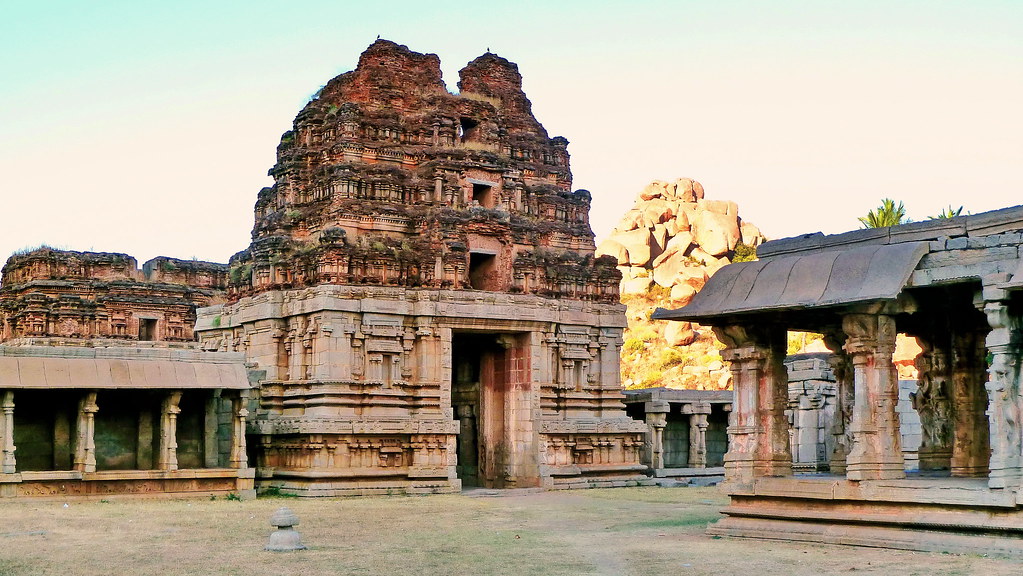
ImageAchyutaraya Temple is the temple of Lord Tiruvengalanatha, a form of Vishnu. The temple was originally named Tiruvengalanath and was established in 1534 AD by Achyuta Deva Raya. The last largest grand creation of the Vijayanagara dynasty, before the fall of the empire. But gradually the temple became popular by the King’s name and hence the name “Achyutaraya”.
When I saw this mesmerizing architecture I was not able to imagine the skills of people at that time.
More on Achyutaraya Temple -> Link1, Link2
2. Monolith Bull / Yeduru Basavanna:
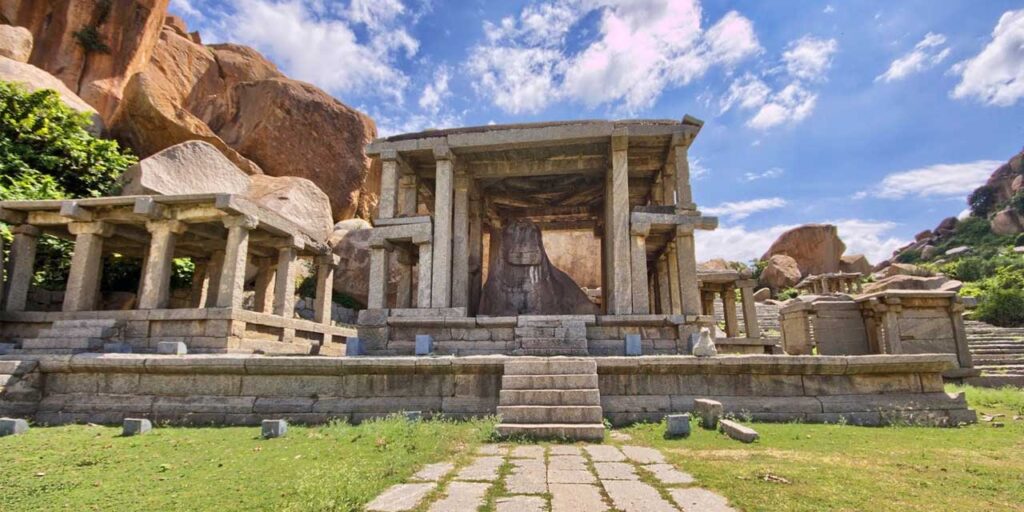
Just while on the way to Achyutaraya Temple, at left you find Monolith Bull. I don’t think anybody can miss this since there is a heap of gigantic boulders behind the statue that offers an interesting backdrop.
Monolithic Bull also known as Yeduru Basavanna and popularly known as Nandi is the mount of lord shiva. The interesting thing is as other Nandis are statutes in shiva temples even this one faces Virupaksha Temple (i.e Shiva shrine). Virupaksha Temple is just at the opposite end of this street (i.e popularly known as Hampi Bajar).
More on Monolith Bull -> Link1
3. Virupaksha Temple:
Virupaksha Temple is one of the oldest functioning temples in India. According to belief, it is said that the function of this temple never stopped (it’s uninterrupted) ever since its inception in the 7th century AD. The temple is of Lord Virupaksha, a form of Shiva, located on the south bank of the river Tungabhadra. The temple was built by Lakhan Dandesha, a nayaka (chieftain) under the ruler Deva Raya II also known as Prauda Deva Raya of the Vijayanagara Empire.
More on Virupaksha Temple -> Link1, Link2
4. Kadalekalu Ganesha:

Kadalekalu means Bengal gram in the local language. The belly of this Ganesh statue resembles a Bengal gram and that’s why this statue is known as Kadalekalu Ganesha. This is one of the largest sculptures in Hampi having a height of 4.5 meters i.e 15 feet. Apart from the sculpture, the pillared hall in front of it has a bunch of beautiful stone works.
More on Kadalekalu Ganesha -> Link1, Link2
5. Lotus Mahal:
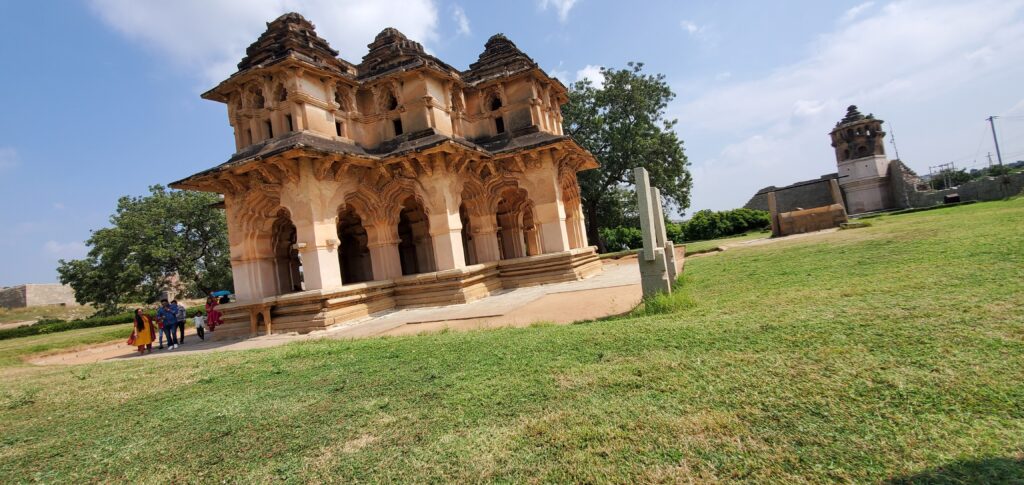
The Lotus Mahal is also known as Kamal Mahal or Chitrangani Mahal is a two-storied structure. It is indeed one of the finest architecturally designed structures, that resembles a lotus.
This mesmerizing beauty is within the Zenana Enclosure, a segregated area that is used by the royal women of the Vijayanagara Dynasty. Where you will also find Elephant Stables.
More on Lotus Mahal -> Link1, Link2
6. Elephant Stables:
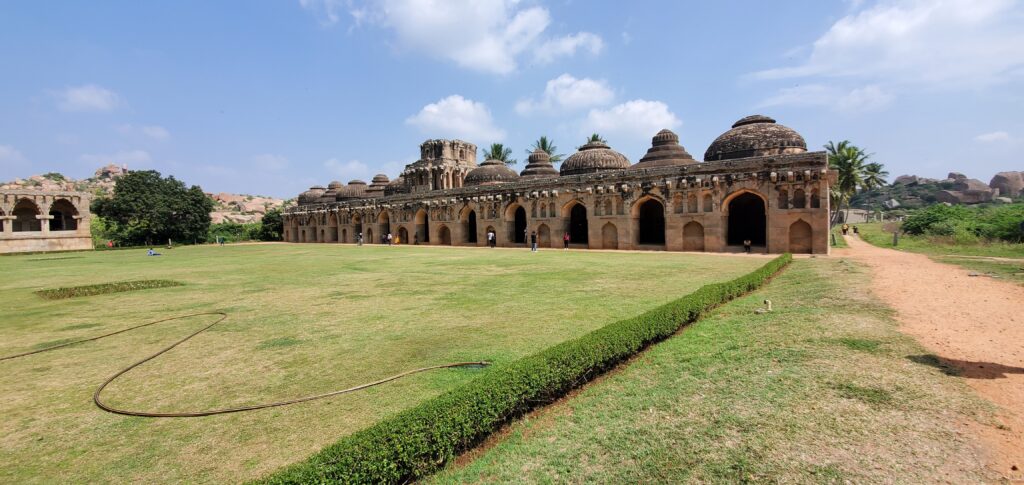
Elephant Stables is a building that was used to keep the royal elephant (more like the resting place of elephants). This is one of the structures that have not been extensively damaged by the Mughal attack. This stable has 11 domes tall chambers, each chamber having a small manhole opening for the mahouts to enter the elephant compartments.
More on Elephant Stables -> Link1, Link2
7. Statue of Ugra Narsimha:
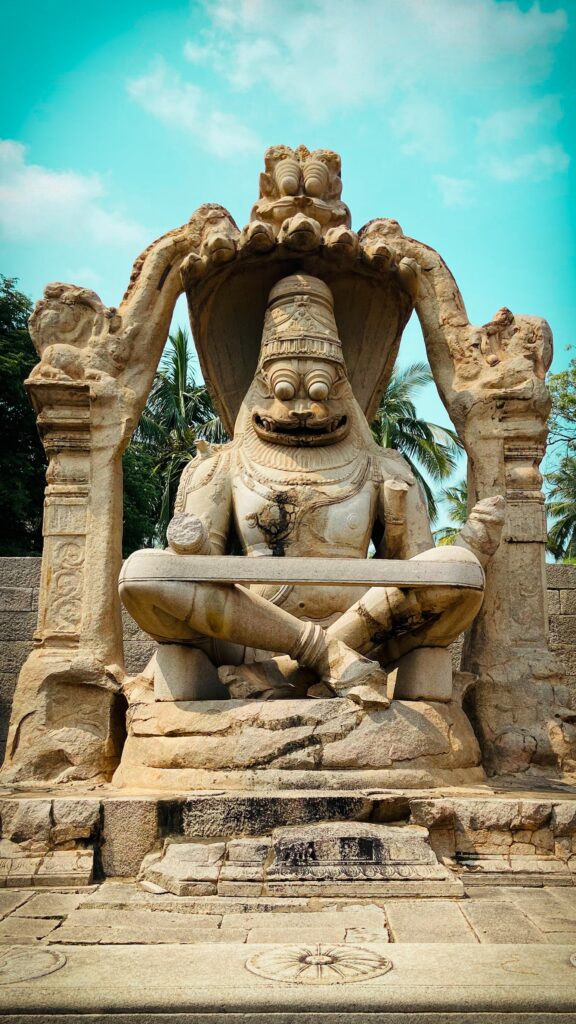
Ugra Narsimha depicts Lord Narasimha in a terrifying or angry form. Narasimha which means half-man and half-lion is one of the ten incarnations of Lord Vishnu. The 6.7m height of this statue makes it the largest statue in Hampi. You can find the statue on the southern side of the Hemakuta group of temples on Hemakuta Hill.
More on Ugra Narsimha statue -> Link1, Link2
8. Badavilinga Temple/Shivalinga:
Shivalinga is just at the side of the Ugra Narasimha statue. This is the largest monolithic Shiva Linga in Hampi, made up of black stone. It has a height of 3 meters. It is believed that the temple has been in existence since the period of the Vijayanagara Empire.
More on Shivalinga -> Link1, Link2
9. Queen’s Bath:
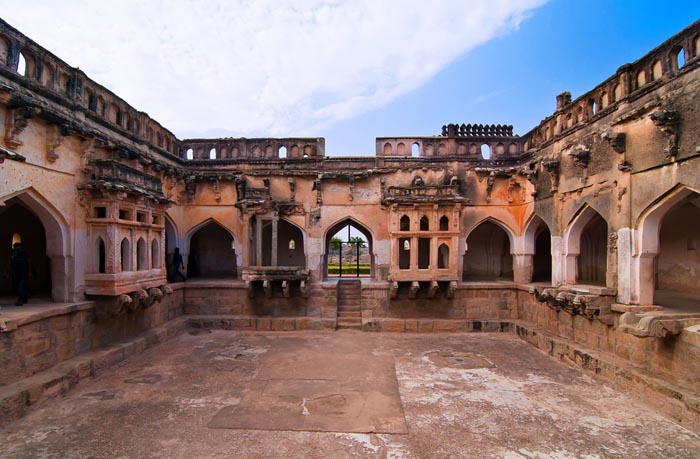
I’m not sure why it is called the queen’s bath. But from my senses, it is called queen bath because this complex was used by kings and his wives for royal pleasure. There is a big open pond in the middle and the whole building has a veranda facing towards it along with a few balconies hanging out on the top of the pond. The Queen’s Bath is believed to have been constructed by Achyuta Raya for the women of the royal family of Vijayanagara.
More on Queen’s Bath -> Link1, Link2
10. Stepped Tank/Pushkaranis:
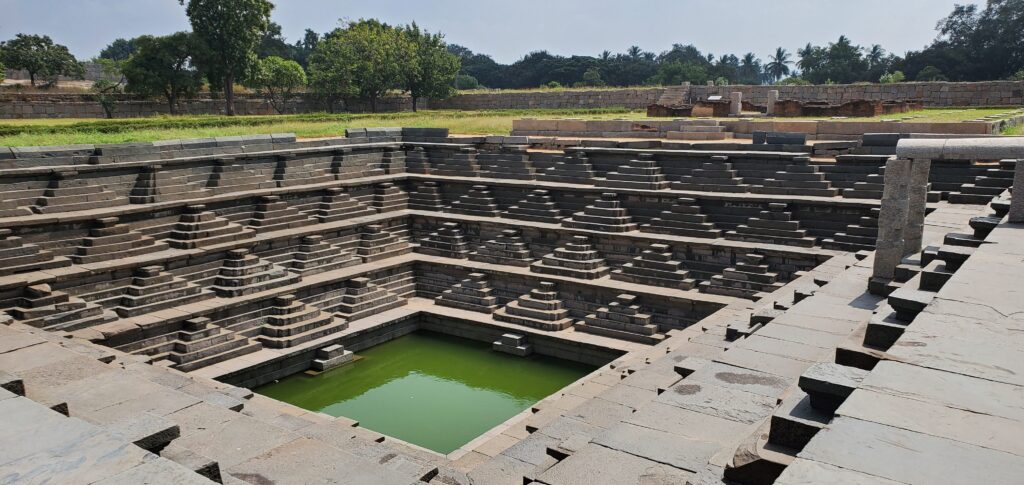
The pushkaranis were a prominent feature of the ruined town, ancient water tanks. Even though the Ganges is thousands of miles away from water tanks, the water in them was considered sacred and part of the Ganges. (Ganges – Hinduism’s most sacred river). The geometrical design steeped tank is at the royal center. The design of his stepped tank is just perfect from all angles.
More on Stepped Tank -> Link1
11. Mahanavami Dibba/Dasara Dibba:
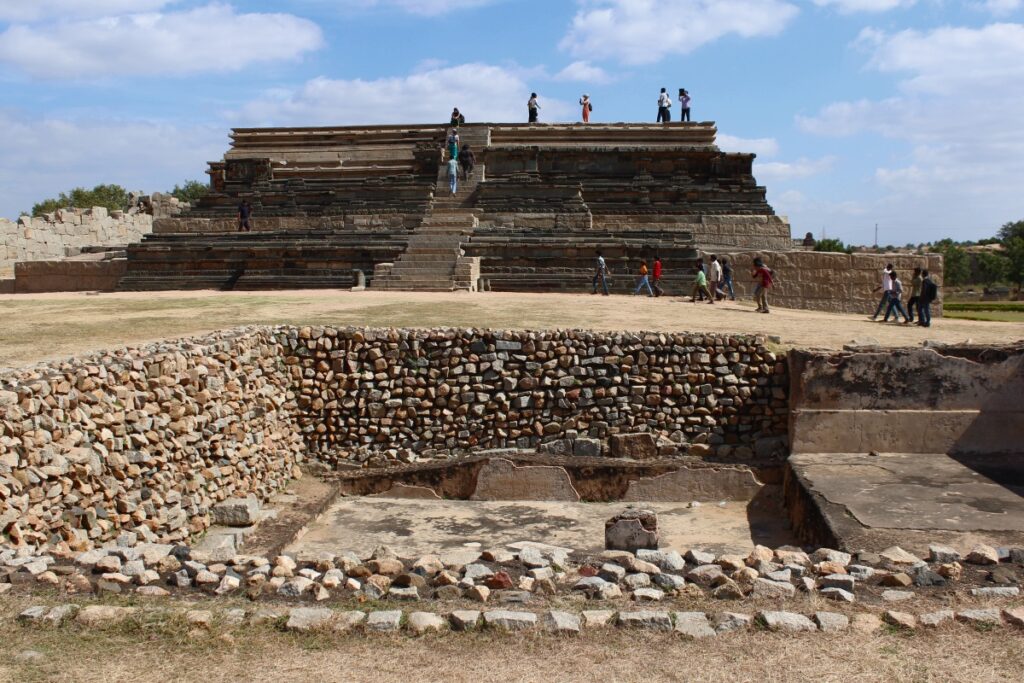
Within the Royal Enclosure from a distance, you see an elevated square stage, this is nothing but Mahanavami Dibba/Dasara Dibba. Built by King Krishnadevaraya during the Vijayanagara period (i.e constructed in 1513 AD). This structure symbolizes the king’s victory over Udaygiri (now in Orissa).
Also when you leave from behind the Mahanavami Dibba you find an impressive pair of monolith stone doors that were once part of one of the entrances of the Royal Enclosure in Hampi. More on stone doors here link.
More on Mahanavami Dibba -> Link1, Link2
12. Vithala Temple Complex:
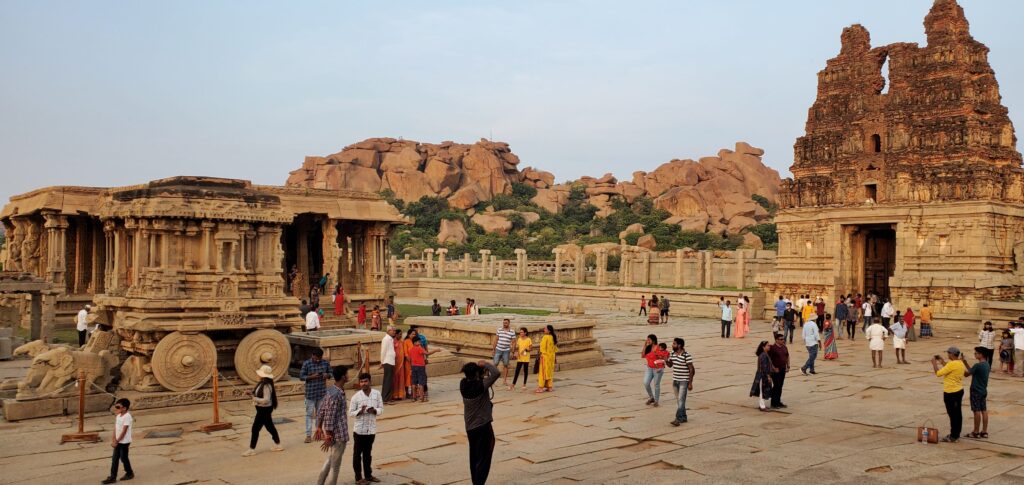
The temple is in the northeastern part of Hampi, near the banks of the Tungabhadra River. Vittala Temple was the place to worship a form of Lord Vishnu. This aspect of Vishnu was worshiped in this part of the country as their cult deity by the cattle herds.
This complex consists of one of the iconic and most famous structures in Hampi. The complex is full of amazing stone structures such as the incomparable stone chariot and the fascinating musical pillars. Truly exceptional architecture and unmatched craftsmanship.
More on Vithala Temple Complex -> Link1, Link2
13. Underground Shiva Temple:
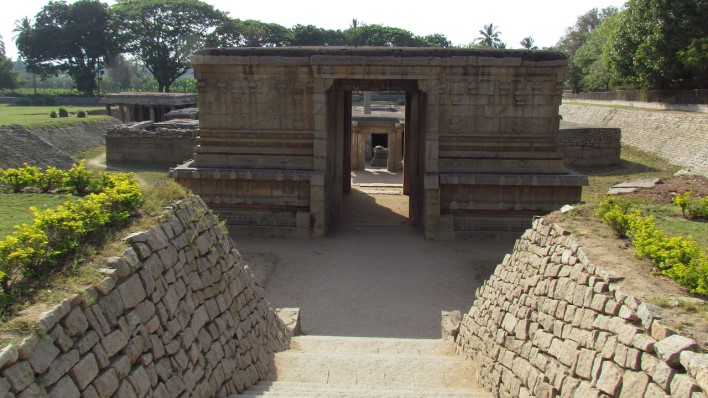
As the name suggests, it’s a shiva temple. But underground means the roof of the temple is at the surrounding ground level. Since the temple is below the ground, almost all the time the sanctum and the core parts of the temple are underwater, restricting entry to the inner areas.
Not just a temple, there is a lawn around it. This area is usually less corded so you can sit on the lawn take some peace full breath, might have you mini snaking.
More on Underground Shiva Temple -> Link1
14. Monkey Temple:
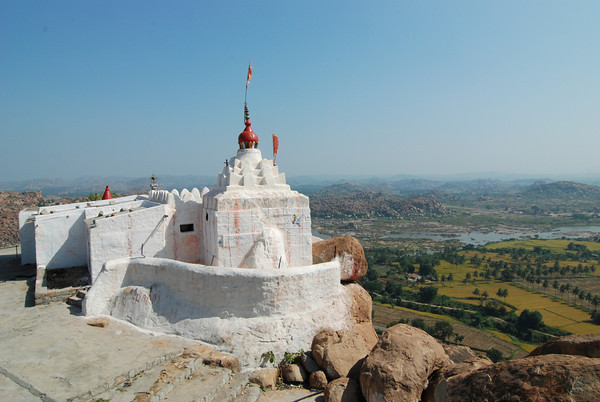
Monkey Temple, a temple of lord hanuman. This place is believed to be the birthplace of Sri Hanuman. Monkey temple is on Anjanadri Hill in Anegundi, Jippie Island. You find lots of monkeys around this temple. To reach this temple you need to climb 575 steps. Once you are there it will be worth it, due to the relatively impressive view at the top.
More on Monkey Temple -> Link1
15. Akka Tangi Gudda/Sister Rock:
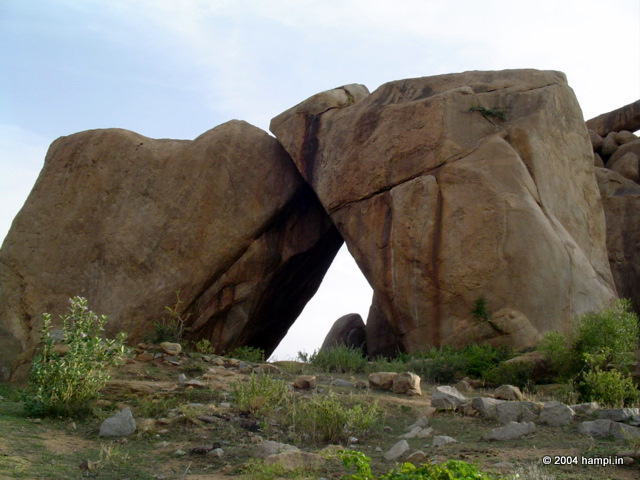
Sister Rock is two gigantic boulders. It is located at Kabaddi Rampura, just near the main road that leads from Hampi to Kamlapur. The particular spot is also known as the ‘hill of the sisters.’
More on Monkey Temple -> Link1
Checkout out my other Travel Experience
If you have any questions or comments feel free to reach me at.
